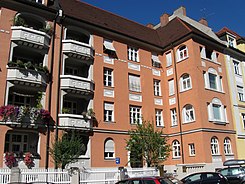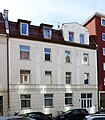Clemensstrasse (Munich)
| Clemensstrasse | |
|---|---|
| Street in Munich | |
| Clemensstrasse 32/34 | |
| Basic data | |
| State capital | Munich |
| Borough | Schwabing-West |
| Connecting roads | Münchner Freiheit , Saarstrasse |
| Cross streets | Leopold Street , Morawitzkystraße, Siegfriedstraße, Wilhelmstrasse, Bismarckstraße, Moltke Street, Victoria Street, Cherubinistraße, Ansprengerstraße, Rossini Street, Belgrade street , Apianstraße, Fallmerayerstraße, Erich Kaestner road Mittermayr road Hiltenspergerstraße, Schleißheimerstraße , Winzererstraße |
| Places | Pündterplatz, Erich-Mühsam-Platz |
| Numbering system | Orientation numbering |
| Subway station | Münchner Freiheit underground station |
| use | |
| User groups | Pedestrian traffic , bicycle traffic , individual traffic |
| Technical specifications | |
| Street length | 1.8 km |
The Clemensstraße is a 1.8 kilometer road in the Munich district of Schwabing . The street named after Clemens August von Bayern (1700–1761) is under the term “Green Axis Schwabing” a participatory model project for all Munich boroughs and Munich's longest bicycle street .
course
Clemensstrasse begins on Leopoldstrasse , crosses Belgradstrasse and Schleißheimer Strasse and turns into Saarstrasse at Winzererstrasse . While relatively small shops line the street in the area between Münchner Freiheit and Wilhelmstraße, Clemensstraße will mainly become a residential street in the further course. Until 2002, the State Academy for Photo Design in Munich was located at Clemensstrasse 33 , which went back to the "Teaching and Research Institute for Photography" founded on October 15, 1900. In the area of Belgradstrasse there are numerous restaurants on both sides, which shape the impression of the street with their free bar areas, especially in the summer months. With a tradition spanning several decades, the “X-Bar” and the z. B. from 1972 to 1976 by Henni Heppel and Wolle Ettlich on "Jennerwein". Also located there at Clemensstrasse 61 was the “Clemensburg”, Munich's only BVB pub, which existed from 1907 to 2015. In the further course to the east, Clemensstraße is primarily a residential street again. The secular institute Ancillae Sanctae Ecclesiae is located at Clemensstraße 113 / IV . The Munich Regional Labor Court is located on the corner of Clemensstrasse and Winzererstrasse .
Architectural monuments
In the area between Münchner Freiheit and Fallmerayerstraße, Clemensstraße is part of the protected building complex Nordschwabing (E-1-62-000-42) over a length of around 1,100 m . Its design is mainly due to the expansion of the city after Schwabing's incorporation into Munich in 1890 and the city expansion competition of 1892 under Theodor Fischer . In total, Clemensstrasse has 36 monuments protected by the Bavarian State Office for the Preservation of Monuments, 26 of them in Schwabing-West and 10 in Schwabing .
Sculpture by the sculptor Klaus Behr at Clemensstrasse 48
1979 created by Undine Werdin sculpture ( Daphne ) at the southern end of the Bayernpark to Clemensstraße
Prominent residents
In 1884/85 the Schwabing hospital was built at Clemensstraße 33. In 1900, a few months after the founding of FC Bayern Munich , the stove and oven manufacturer Friedrich Wamsler senior, whose sons were among the founding members, gave the club a fenced-in property at Clemensstrasse 50 as a venue, until 1907 the move to the club Leopoldstrasse and Parzivalplatz took place. The first Munich city derby also took place here on September 21, 1902 .
From 1906 to 1910, Alexander Roda-Roda lived at Clemensstrasse 2. From 1917 to 1919, Ret Marut lived at Clemensstrasse 84 / III , where he was the editor of Der Ziegelbrenner .
From autumn 1967 Edgar Hilsenrath lived at Clemensstrasse 28. Rainer Werner Fassbinder and Juliane Lorenz lived at Clemensstrasse 76 . Alexander Koester lived on Clemensstrasse (while his studio was on Leopoldstrasse ). Jochen Winter lived on Clemensstrasse.
In November 2019, a memorial stele was attached to Michael Strich's former home at Clemensstrasse 41 as part of the Memorial Signs for Victims of the Nazi Regime project in Munich .
Web links
Individual evidence
- ↑ Myriam Siegert: Here drivers have (almost) nothing to report In: Abendzeitung April 26, 2013
- ^ "Green axis Schwabing" is a model project for all neighborhoods In: Münchner Wochenanzeiger May 13, 2014
- ↑ Beate Wild: Schwabinger Trash In: Süddeutsche Zeitung October 26, 2010
- ↑ Lars Langenau: In the cave of the poacher In: Süddeutsche Zeitung November 17, 2011
- ↑ Thierry Backes: The mother of all pints In: Abendzeitung August 22, 2012
- ↑ Ursula Auginski: Alpenkitsch and Diva Desaster In: Süddeutsche Zeitung August 21, 2008
- ↑ Ellen Draxel: The battle for the living room In: Süddeutsche Zeitung May 11, 2015
- ^ List of monuments for Munich of the BLfD
- ^ Geographical Society Munich : Communications of the Geographical Society in Munich . tape 42-43 , 1957, pp. 60 ( limited preview ).
- ↑ First FC Bayern Munich venue rediscovered In: br.de August 25, 2018
- ↑ Kristian Bäthe: Who lived where in Schwabing? Süddeutscher Verlag , 1965, p. 236 ( limited preview ).
- ^ Robert Schurz: Alexander Roda Roda in Munich In: Bayerischer Rundfunk April 21, 2013
- ↑ Dirk Heißerer: Where ghosts wander: Literary walks through Schwabing . Verlag CHBeck , 2017, ISBN 978-3-406-70253-2 , p. 233 ( limited preview ).
- ^ W. Stock: B. Traven lives in Munich, Clemensstrasse 84 August 10, 2010
- ↑ Helmut Braun: I am not Ranek: Approaching Edgar Hilsenrath . Dittrich Verlag , 2014, ISBN 978-3-943941-46-3 , pp. 233 ( limited preview ).
- ↑ Ruth Stein: Alexander Koester, 1864-1932: Life and Work . Aurel Bongers Verlag, 1988, ISBN 978-3-7647-0399-8 , pp. 233 ( limited preview ).
- ^ Bavarian Academy of Fine Arts : Yearbook . tape 15 . Verlag CHBeck , 2001, p. 217 ( limited preview ).
- ↑ https://www.sueddeutsche.de/muenchen/muenchen-erinnerungszeichen-michael-strich-1.4688634
Coordinates: 48 ° 9 ′ 48.6 ″ N , 11 ° 34 ′ 27.8 ″ E








